RATHER MACABRE
Although I knew a little about the Golem, it wasn’t until I went to Prague with my Mother a long time ago that she «introduced him to me.» Her story was filled with laughter and although I can’t remember too much about what she told me, I am sure that there would have been a side which was highlighted by her own fantasy.
As I was going to see the exhibition at the Jewish Cultural section, I brushed up my rather scanty knowledge. This is what I found
The Golem is a mythical creature created out of clay that is brought to life. The most famous version of the legend is set in late 16th century Prague. The High Rabbi Lowe, a man learned in kabalistic lore, forms a man-like creature out of clay and then bring it to life by inserting a shem (capsule) with a written magic formula into its mouth. He also writes the German word for truth, anmauth, on its forehead. The Golem, which is given the name Joseph, does the work around the Jewish Quarter of Prague, sweeping the streets, carrying water, splitting wood etc. The Golem was tireless and uncomplaining; it needed neither food nor drink. It was exceedingly strong and fearless and defended the Jewish Quarter from attacks.
The only care required of the Golem was that it must not be alive on the Sabbath (Saturday). Rabbi Lowe deactivated the Golem by removing the shem from its mouth on Friday evenings before the Sabbath began. One Friday evening Rabbi Lowe forgot to remove the shem and Joseph the Golem went berserk. As mentioned above Joseph was very strong; he started pulling up trees. The rabbi ran after Joseph and managed to pull the shem from his mouth thus immobilizing him.
The Habsburg emperor, Rudolph II, was fascinated with arcane lore, so much so that he moved his residence to Prague which was at the time well known as a center of interest in the black arts of alchemy, astrology, necromancy, kabalism and other fields mysticism. Dr. Faust was reputed to have lived in Prague.
In the Golem legend Joseph was so effective at defending the Jewish Quarter that complaints reached Rudolph II. Rabbi Lowe was summoned to Prague's High Castle for a midnight audience with Rudolph. The purpose of the meeting was never revealed but it was believed that Rudolph offered Rabbi Lowe a deal. If the Golem was permanently deactivated Rudolph would prevent any further attacks against the Jewish Quarter. There was however another possible subject for the meeting. Rudolph was having an affair with the beauteous wife of the mayor of the Jewish Quarter and Rabbi Lowe had found out about it.
There were two versions of how the Golem was permanently deactivated. In one version the word anmauth (truth) written on Joseph the Golem's forehead was changed to mauth (death) by erasing the an. In the second version, Joseph is told he can only sleep in the attic of the synagogue. While he is asleep there Rabbi Lowe and his assistants perform a ritual of circling seven times around the sleeping Joseph while reciting magic formulas. They then wrap the lifeless body in prayer shawls and conceal it in that attic. No one is allowed to go to the attic of that synagogue and the clay body of the Golem is still there to be reactivated if need be.
There were a few minor elements to the legend that are of interest. One, the Golem was not given the power of speech for that would give him a soul. Two, the Golem began to go out of control as in his uprooting of trees on the Sabbath when he was not deactivated. Also Joseph the Golem became infatuated with the beautiful daughter of Rabbi Lowe.
These elements indicate that the legend had cultural lessons embedded in it as the anthropologist Claude Levi-Strausse argued that all successful legends have. First, note that the creation of a living creature out of clay is a spinoff of the Genesis legend of the creation of Adam, the first man. Adam was first constructed of clay and then Jehovah breathed life into him. The word adam means ground, dirt, earth or clay. The Hebrew word golem has a similar meaning as raw material. The lesson of the Golem legend is that only Jehovah has the right to create a living creature. For humans to usurp that right is not only dangerous but may be evil as well. The second lesson is that once a living creature is created there is no guarantee of control over the actions of that creature. Witness the disobedience of Adam and Eve in the Garden of Eden.
The Golem legend entered European culture and reappeared in various forms. The Hunchback of Notre Dame, The Incredible Hulk, Dr. Frankenstein and his monster and The Sorcerer’s apprentice.
The exhibition opens with the story and there is a lot of text to read. I don’t always read it either. My first thoughts were that this is difficult to photograph, so I won’t. Then I came across this and the photographs worked their way onto the iPhone. I couldn’t imagine anything less frightening. The Golem was created by a Belgium artist Maurice Pomeranc (1919-) in 1997

Maryan or Pinchas Burstein (1927–1977), later known as Maryan S. Maryan, was a Polish-born Jewish painter. I have talked about his work over the years and this is The Golem in 1955. He was the only member of his family to survive the Shoah and here he is showing us a Golem wounded by history. He is frightened, teary-eyed, his half open mouth incapable of screaming. The Golem’s mask-like face seems petrified as if he has reverted to his initial inertia. The star of David he is wearing makes him a symbol of the Jewish community forever wounded by the war.
Niki de Saint Phalle created this Model of the Golem. In actual fact it is a giant slide which children can climb on a staircase at the back. This creature is a friendly monster and is perhaps portrayed as protective and welcoming to all.
 |
| Gerard Garouste |
You have also seen Gérard Garouste’s work. (French, 1946-) In my book he is unmistakeable. For « The Golem » of 2011 he got his inspiration for this picture from a passage in Franz Kafka’s Diaries in 1916, describing the creation of a golem by a rabbi feverishly kneading clay in a tub. All those creatures around the golem are actually tasting it with their tongues. All are surprised that it has a bitter flavour. Demonic.
Another artist I don’t know. Jules Kirschenbaum (1930-2000). He was an American painter. This is a synthesis between the story of the Golem and Mary Shelley’s Frankenstein. I will let your imagination flow while looking at the picture.
These are much more palatable. Sketches for the production of Golem (1931) done by the Czech painter Otakar Schindler who is best known as a theatre designer. These sketches convey a humorous and satirical narrative. The rabbi creates a Golem to punish his aunt for misplacing his trumpet. But the Golem falls madly in love with her but is rejected so commits suicide. Well it’s not the brightest story I have heard but the sketches are delightful.
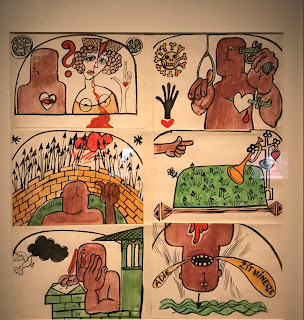 |


This is just one of four Illustration for The Golem by Max Weber (an American: 1918) Weber is regarded as one of the first American cubists.
 |
Once again these sketches are designed for the theatre by Ignaty Nivinsky who played an active part in the effervescence in Russian theatre in the 1920’s. He worked on the production of The Golem by a theatrical company in Moscow. As he didn’t speak Hebrew he tried to understand by producing traditional Jewish amulets (an object worn, especially around the neck, as a charm against evil or injury) depicting fantastic hybrid golems in which animals, machines and magical elements intermingle. Apparently most of them were rejected as they had little to do with the original text!
 |
 |
 |
 |
Most of Michel Nedjar’s work (French, 1947-) consists of making dolls out of fabric, earth, mud and clay. These dolls seem to have just emerged from the earth and evoke The Golem. They come from the Paris, Belleville series (1985-87) and are made out of fabric, glue and dye.

This is a Terracotta Urn created by Jeanclos in 1978. He had done a series of funerary urns dedicated to his father. The link between his work and the figures of the Golem is particularly strong because in these series he was exploring the power and meaning of the Hebrew letter. It was after his father’s death that he rediscovered his Jewishness.
 |
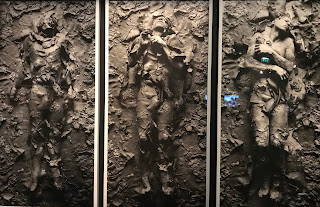 |
Pierre Minot’s work (French, 1948-) is equally macabre. These show a being taking form and gradually detaching itself from the ground which it seems to be a part.
But on a lighter scale Zaven Paré (Algerian 1961-) is fascinated by machines and explored figures of the robot regarding the Golem as one of its ancestors. Here he has transformed the Golem’s creator the Rabbi Loew into an artificial being, a metallic humanoid. Now it’s no longer the Golem who resembles man but the man who resembles the Golem.
These Golems fascinated me because of the Japanese script in the background. I thought the artist may have been Japanese, but no, Zaven Paré again. These came about during his stay at Hiroshi Ishiguro’s Intelligent Robotics Laboratory in Osaka…
 |
To finish on a lighter side, here are a series of Robots which can all be customised. Poppy is followed by others, big and small.
 |
And there it was kneeling in front of the museum a sculpture by Antony Gormley done in 2013 and called Clench. He actually used his own body as a mould and to produce a double self…
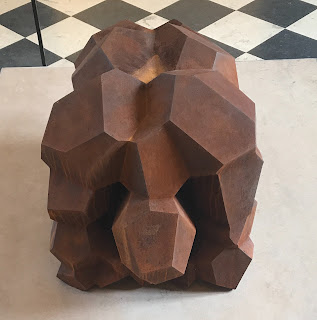 |
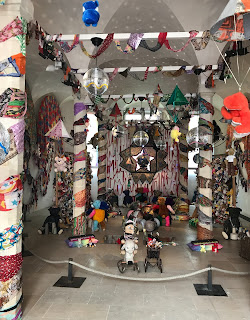 |
I wanted to finish with a smile. This is the poster I saw coming out of the Institute.
 | |
Here he uses a « crazy » acoustic and visual universe. You would have thought that there would be lots of children looking at this rather odd world. Well, I was the only child. The music and sound was not working but I could wander around in this little world and think about nicer things…












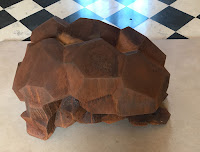






Commentaires